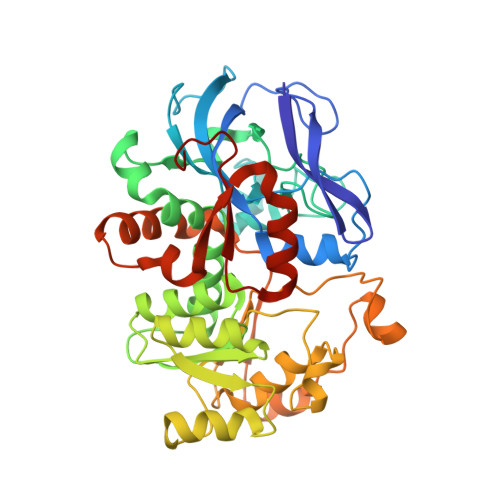Crystal Structure of Formaldehyde Dehydrogenase from Pseudomonas putida: the Structural Origin of the Tightly Bound Cofactor in Nicotinoprotein Dehydrogenases
Tanaka, N., Kusakabe, Y., Ito, K., Yoshimoto, T., Nakamura, K.T.(2002) J Mol Biol 324: 519-533
- PubMed: 12445786
- DOI: https://doi.org/10.1016/s0022-2836(02)01066-5
- Primary Citation of Related Structures:
1KOL - PubMed Abstract:
Formaldehyde dehydrogenase from Pseudomonas putida (PFDH) is a member of the zinc-containing medium-chain alcohol dehydrogenase family. The pyridine nucleotide NAD(H) in PFDH, which is distinct from the coenzyme (as cosubstrate) in typical alcohol dehydrogenases (ADHs), is tightly but not covalently bound to the protein and acts as a cofactor. PFDH can catalyze aldehyde dismutations without an external addition of NAD(H). The structural basis of the tightly bound cofactor of PFDH is unknown. The crystal structure of PFDH has been solved by the multiwavelength anomalous diffraction method using intrinsic zinc ions and has been refined at a 1.65 A resolution. The 170-kDa homotetrameric PFDH molecule shows 222 point group symmetry. Although the secondary structure arrangement and the binding mode of catalytic and structural zinc ions in PFDH are similar to those of typical ADHs, a number of loop structures that differ between PFDH and ADHs in their lengths and conformations are observed. A comparison of the present structure of PFDH with that of horse liver ADH, a typical example of an ADH, reveals that a long insertion loop of PFDH shields the adenine part of the bound NAD(+) molecule from the solvent, and a tight hydrogen bond network exists between the insertion loop and the adenine part of the cofactor, which is unique to PFDH. This insertion loop is conserved completely among the aldehyde-dismutating formaldehyde dehydrogenases, whereas it is replaced by a short turn among typical ADHs. Thus, the insertion loop specifically found among the aldehyde-dismutating formaldehyde dehydrogenases is responsible for the tight cofactor binding of these enzymes and explains why PFDH can effectively catalyze alternate oxidation and reduction of aldehydes without the release of cofactor molecule from the enzyme.
Organizational Affiliation:
School of Pharmaceutical Sciences, Showa University, 1-5-8 Hatanodai, Shinagawa-ku, 142-8555, Tokyo, Japan. ntanaka@pharm.showa-u.ac.jp

















